Semi Finals
Nadal Berrettini, Medvedev Tsitsipas, and a bit on the Medvedev Auger-Aliassime epic
Medvedev Auger-Aliassime epic
First, a quick bit on Medvedev’s 5 set comeback win against Auger-Aliassime yesterday. Auger Aliassime (FAA) played brilliantly for most of the match, and the first three sets especially were as complete a performance I’ve seen from him at the elite level. He got unlucky with a rain delay while mere points away from a straight sets victory, in the 3rd set tiebreaker, and after that Medvedev mostly hunkered down and did what we all know he’s capable of (and even saved a match point along the way with the Russian’s fastest serve of the match).
The rally dynamics changed pretty significantly after set three however. For the first three sets Auger-Aliassime had done what most of Medvedev’s opponents aren’t able to by figuring out ways to out-baseline Medvedev. After Auger Aliassime won the ATP Cup with Canada a few weeks ago I wrote this about his straight sets win over Bautista Agut:
Auger-Aliassime hit plenty of brilliant forehands today, both out of his backhand corner and from his forehand corner. That shot, alongside the 1st serve, certainly took most of the glory. But, after a slightly shaky first few games, Auger-Aliassime managed to take away most of the strategic rally edge Bautista Agut was looking to hold, i.e the backhand to backhand battle. Bautista Agut was therefore forced into two bad options:
either keep trading cross court with Auger-Aliassime, which because of Bautista Agut’s backhand technique tends to land quite central rather than angled which gives Auger Aliassime more opportunity to run around the backhand to hit an aggressive forehand…
…or just hit into Auger-Aliassime’s forehand which was mostly a losing play because of how devastating that shot was today.
And this, partly because Medvedev also has a flat backhand and often hits quite central with the backhand cross court, happened again for much of the first three sets. Auger-Aliassime showed great patience and resilience with his backhand and chose the right opportunities to run around that shot and hit big forehands. Medvedev had little answer. FAA also returned 2nd serves brilliantly and aggressively, which put more pressure on Medvedev’s 1st serve than he is used to, and was serving accurately and excellently himself which completely confounded Medvedev’s stubbornly deep return position.
— ↑ FAA (in white and red) did this time and time again in the first three sets. Comfortably and consistently trades backhands with Medvedev, waits for the right ball to run around and then goes big with a forehand, often inside-in like this one. Medvedev was often caught waiting for the Auger-Aliassime backhand to break down but, at least for the first 2/3’rds of the match, it stayed solid and enabled Felix’s forehand to shine.
But as the match progressed Auger-Aliassime started to miss shots on both forehand and backhand that he was making earlier (and lost some of the forehand width). And was also hurt by some untimely double faults. At the other end of the court Medvedev started to find ever-better serve spots (especially out wide on both Deuce and T serves) as well as improved baseline depth and penetration.
To be clear, Auger-Aliassime didn’t obviously dip during any of the match, and even held break points to start the 5th set. The Canadian was still returning and serving well for parts of the latter half of the contest. But a lot of the rally dynamics that had put so much pressure on Medvedev for the first three sets disappeared:
Point length differentials
— 0-4 shots, sets 1-3 —
Auger Aliassime 69 (points won), Medvedev 65 — Auger Aliassime +4
— 0-4 shots, sets 4-5 —
Auger Aliassime 51, Medvedev 39 — Auger Aliassime +12
— 5+ shots, sets 1-3 —
Auger Aliassime 42, Medvedev 37 — Auger-Aliassime +5
— 5+ shots, sets 4-5 —
Auger Aliassime 20, Medvedev 41 — Medvedev +21!
The transition from Auger-Aliassime edging the 5+ shot points for the first three sets, to Medvedev dominating them, was stark. Medvedev won more of his total points in the last two sets in points over 5 shots than under (41 to 39). Amazing match.
Both the Nadal vs Berrettini and Medvedev vs Tsitsipas matchups have similar themes. Both feature what is often an uneven return of serve dynamic (on hard courts). Nadal will usually be the better returner compared to Berrettini and Medvedev will usually be the better returner compared to Tsitsipas. When looking at upcoming matches like tomorrow’s semi final’s I like to start with the matchup as a base and then plonk variables like form on top.
Nadal vs Berrettini (day match)
The only time these two have met was the semi finals of the 2019 US Open. That day I wrote this:
Nadal’s serving performance today was exceptionally clean, being taken to deuce just once(!), and facing 0 break points. This was partially down to Rafa’s newly aggressive 2nd serve speeds (avg today was 97mph) and placement, but also to one of the bigger shortcomings in Berrettini’s game.
Nadal won 90% (37/41) of his 1st serve points and, even more impressively, 74% (25/34) on 2nd serve. That 2nd serve % is rare in a modern slam semi-final between two top players.
Something interesting also happened in the middle of the 2nd set, with Nadal suddenly figuring out Berrettini’s favourite wide 1st serve on the AD side.
The biggest potential problem for Berrettini in this matchup is informed by how little he managed to do on Nadal’s serve when they previously met (0 break points and only pushed to deuce once). Rafa, as a lefty, was very comfortable hitting T serves on the Deuce side and wide serves on the AD side into Berrettini’s backhand.
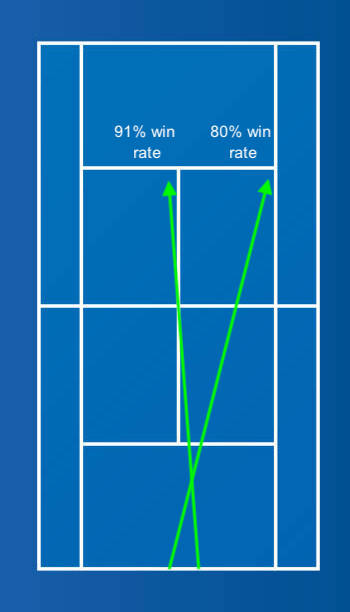
One of the standout things in Nadal’s title run at the US Open back in 2019 was his aggressive 2nd serve, averaging 97mph (156kph) against Berrettini that day. Unfortunately for Berrettini, and something that has slipped mostly under the radar at this year’s Australian Open, is that Nadal is consistently averaging the fastest 2nd serves of his career (102mph or 164kph avg across the first five rounds). This means that if Nadal serves close to as well as he has been (outside the various physical dips we’ve seen in a few of his matches), Berrettini is probably going to have his work cut out on return once again.
Berrettini’s backhand probably gets an unfair amount of criticism. It’s a shot that can certainly be exposed in some matchups, but against most of the tour it actually holds up well for the most part and his excellent slice backhand picks up a lot of slack. The problems for Berrettini in this particular matchup however, are that the slice/blocked backhand returns are likely to get eaten up by Nadal far more readily than against most other opponents, meaning that he may need to take more risks on return with his two hander. And in rallies, Berrettini’s options to slice are reduced against Nadal compared to the rest of the tour considering, at least historically, how well Nadal deals with slices (Nadal can also try and coax Berrettini slices by slicing his own backhand down the line low into Berrettini’s backhand).
How Berrettini navigates this, both on backhand return and backhands during rallies, will be key tomorrow. The Italian used drop shots (especially serve +1 dropshots) effectively at the start of that 2019 match, in order to avoid developing some of the bad rally patterns, and to capitalise on Nadal’s deep court position on return. It’ll be interesting to see whether he tries more of the same tomrrow.
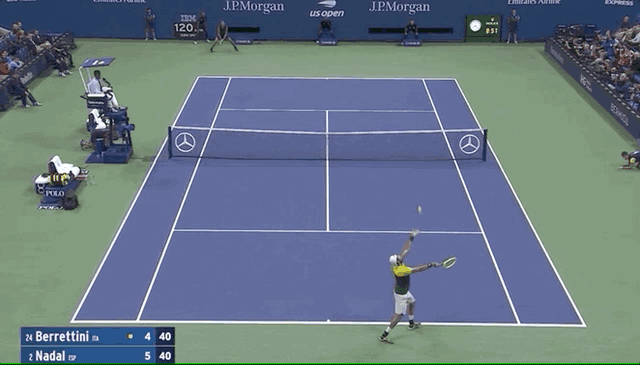
But it’s not all bad news for Berrettini. The Italian has improved across the board since 2019 and Nadal has also probably gotten worse in some areas (notably physically). Berrettini is also in better form and has much more recent matchplay under his belt than Nadal, who has only played single digit number of matches in the last 6 months. Berrettini’s serve and forehand +1 are also awesome enough that, even if Nadal serves well, the Italian may well be able to look after his own service games long enough to force tiebreaks where anything can happen (for e.g Berrettini could easily have won the 1st set breaker in their 2019 match). If Berrettini comes out with his serve firing then a few tight tiebreakers could well make the difference, and if Berrettini can force this match to go long, then Nadal’s physical resilience, which has come into question this tournament, could also be a factor. We’re also looking at high humidity conditions tomorrow in Melbourne which historically haven’t favoured Nadal and his propensity to sweat.
The raw matchup details favour Nadal, as does Berrettini’s 0-6 record against Top 10 players in Slams. But Berrettini, in the prime of his career, has sufficient weapons to make any match close, has struck his weaker backhand wing well for most of this tournament (his backhand technique is also sufficiently flat that it can rush Nadal’s forehand cross court during purple patches), and some questions remain about Nadal’s form in general. It’s up to you how you weigh those things. Matchup dynamics are usually more influential unless there are some large deviations in form either way.
Medvedev Tsitsipas (night match)
Similar to Nadal vs Berrettini, Medvedev historically has enjoyed a return advantage over Tsitsipas on hard courts. Their match this time last year on the same court was the perfect example of that advantage, with Medvedev landing a high 20% ace rate and winning nearly 90% of his 1st serve points compared to Tsitsipas’ 61%.
Tsitsipas has had hard court success against Medvedev however, most of all in his straight sets win at the ATP Finals in London in 2019. In that match Tsitsipas served his spots superbly all match long which helped him edge a crucial, and tight, first set tiebreaker (he didn’t face a single break point in that match). If Tsitsipas can serve at a similar level tomorrow, he can absolutely win this semi-final. But that serve is going to have to be firing, and most importantly landing, in the right places:
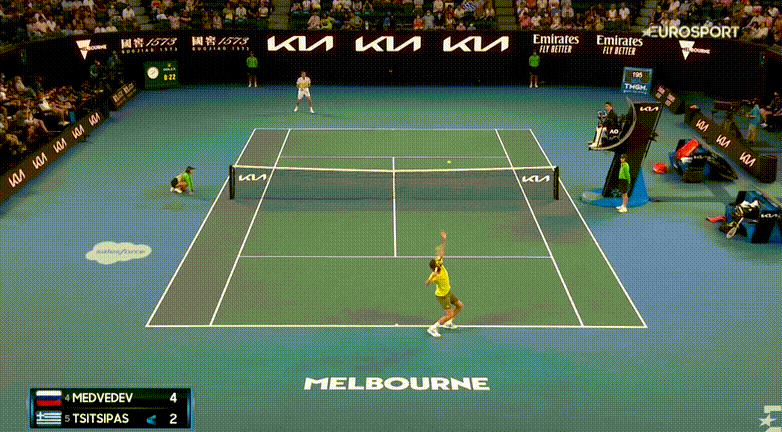

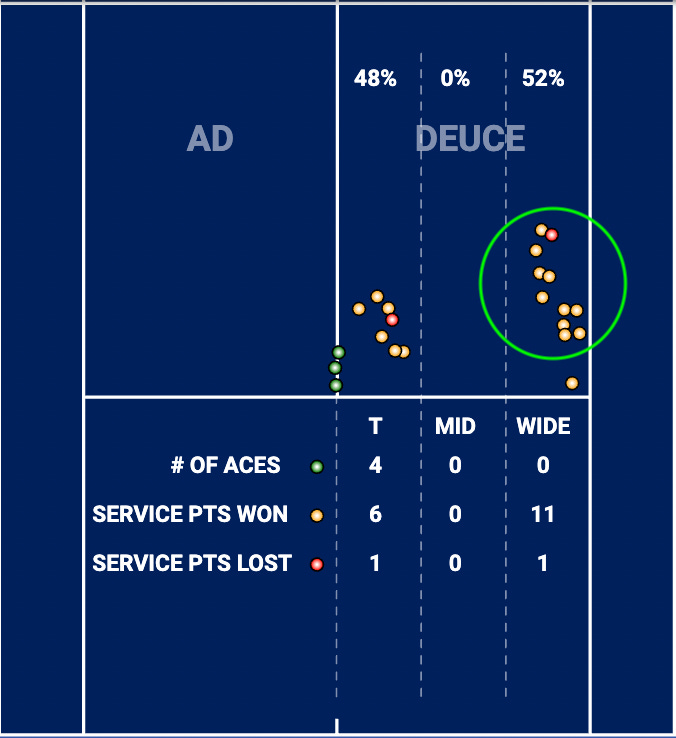
Rally
Also similar to Nadal Berrettini, on a hard court at least, Medvedev has had a lot of success against the Tsitsipas backhand in rallies. The problem is multi-layered:
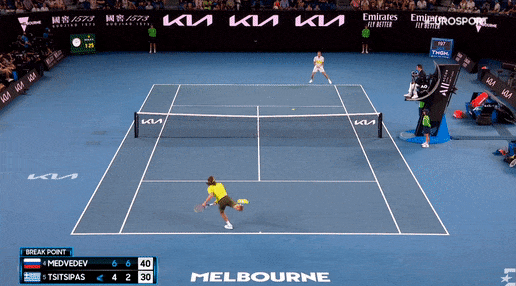
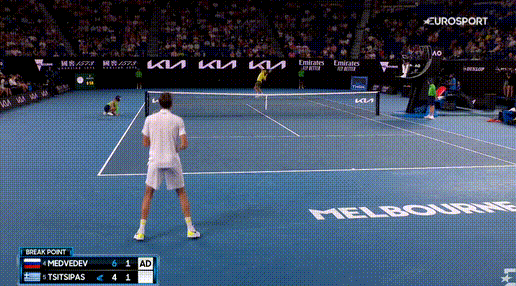
— ↑ 3. Thirdly, because Tsitsipas is worried about the backhand to backhand exchanges, he often ends up camping in that backhand corner in order to give him more time to play the backhands. This then opens up the line for Medvedev to hit his own backhand down the line which is often easier for a double hander than a single hander.
But Tsitsipas can do things to mitigate both the return and rally issues. His blocked return is ever improving, which may be able to bring Medvedev into net (where he’s still not that comfortable). His slice backhand has also been sporadically quite effective in earlier rounds this tournament, and his down the line backhand has also been impressive, both of which may well help him in the backhand to backhand rally exchanges if he can have an above average day on those shots. His backhand is aiming to set up forehand opportunities and not leak errors much more so than it’s aiming to hit winners or force errors. But should none of those materialise, then Tsitsipas still has the core parts of his game to lean on. And those core parts are great enough to trouble Medvedev if they’re firing, regardless of what’s happening on Medvedev’s side of the court. If Tsitsipas can hit his spots consistently enough on serve he should be able to force, at least, close sets. And if he’s doing that then his wonderful forehand (which at its best is even more devastating than Auger-Aliassime’s was yesterday) and net skills will have slotted into place and will make Medvedev’s life difficult. Anything less and, as long as Medvedev’s level is solid, a repeat of last year’s semi final in Melbourne looks probable.
The question of form is less predictable, because I think Medvedev has probably played too much tennis recently (played Davis Cup and ATP Cup giving him a non-existent off season) and isn’t quite at the level he was this time last year when the two players met, and Tsistipas is coming into this tournament after keyhole elbow surgery (although has played some stunning tennis in demolishing Jannik Sinner last round).
My hunch is that this match stands a good chance of being much closer than this time last year. How close largely depends, other than obvious deviations in form either way, on Tsitsipas’ serve. Everything that can make this matchup extremely competitive flows from Tsitsipas’ serve potency and resulting forehand dominance. Usually that’s the primary aspect of this matchup which can close Medvedev’s hard court edge.
Through the first 5 rounds
Service Games Won
95% Nadal (78/82)
95% Medvedev (93/98)
94% Tsitsipas (90/96)
91% Berrettini (93/102)
Return Games Won:
28% Nadal (22/78)
23% Tsitsipas (21/93)
18% Medvedev (18/98)
18% Berrettini (18/101)
Small sample sizes and matchup differences can skew these numbers a bit, and Medvedev has inarguably played bigger servers to get to this stage than Tsitsipas.
A brilliant semi finals day awaits. Enjoy.
— MW
Twitter: @mattracquet
I’ll see paid subscribers on Sunday for Australian Open final analysis!
The Racquet goes out twice a week, a (free) piece every Thursday and a (paid) analysis piece every Sunday/Monday. You can subscribe here:
Top: Mark Metcalfe/Getty
Most recent:

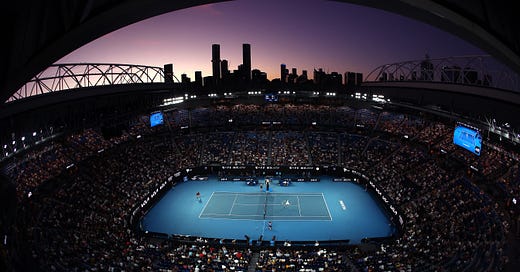


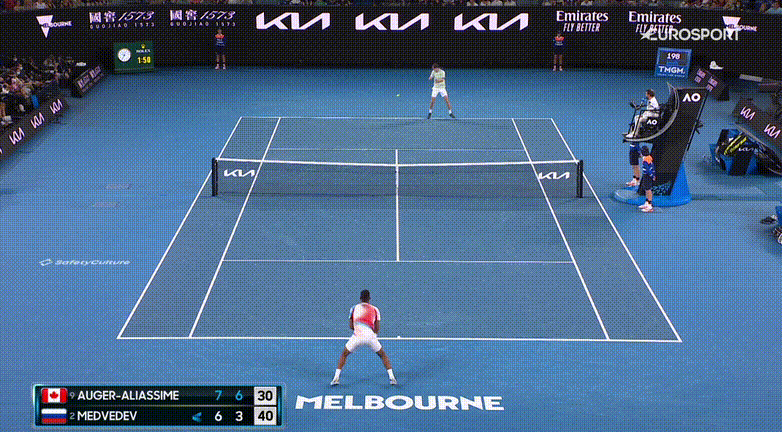

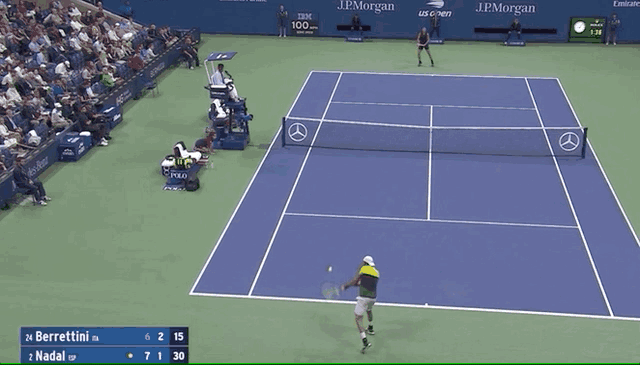
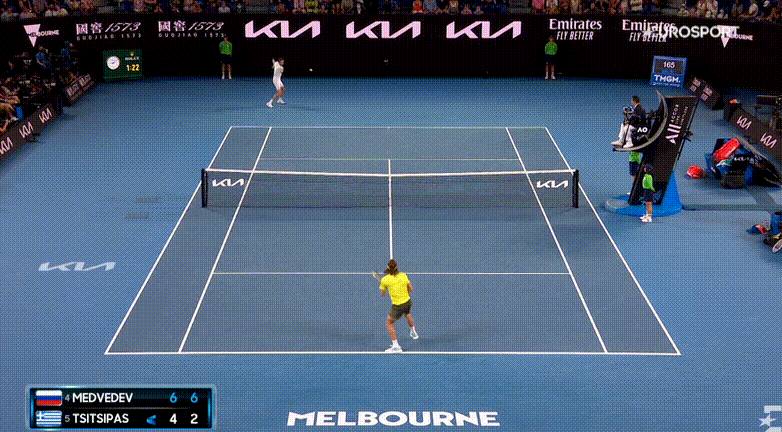

Nice to have the write-up before the match as a change of pace. I too noticed Nadal's high second serve speed (and for him high first too) and he even mentioned it in his post-game interview that he went aggressive on second serve in 5th set due to his fatigue/illness. I suspect this was a strategy going into the tournament due to his uncertainty about playing long points with the foot injury still not fully healed.
You have a typo in thrid to last last sentence:
Small sample sizes and matchup differences can skew this numbers a bit, and Medvedev has inarguably played bigger servers to get to this stage than Medvedev.
I assume you meant Nadal as playing the lesser servers.
Very rushed writing today so excuse multiple typos and a mistake with the first GIF (it was 198mb's so will not load). Fixed now, so you can tap the title to load the updated web version or tap here: https://theracquet.substack.com/p/semi-finals